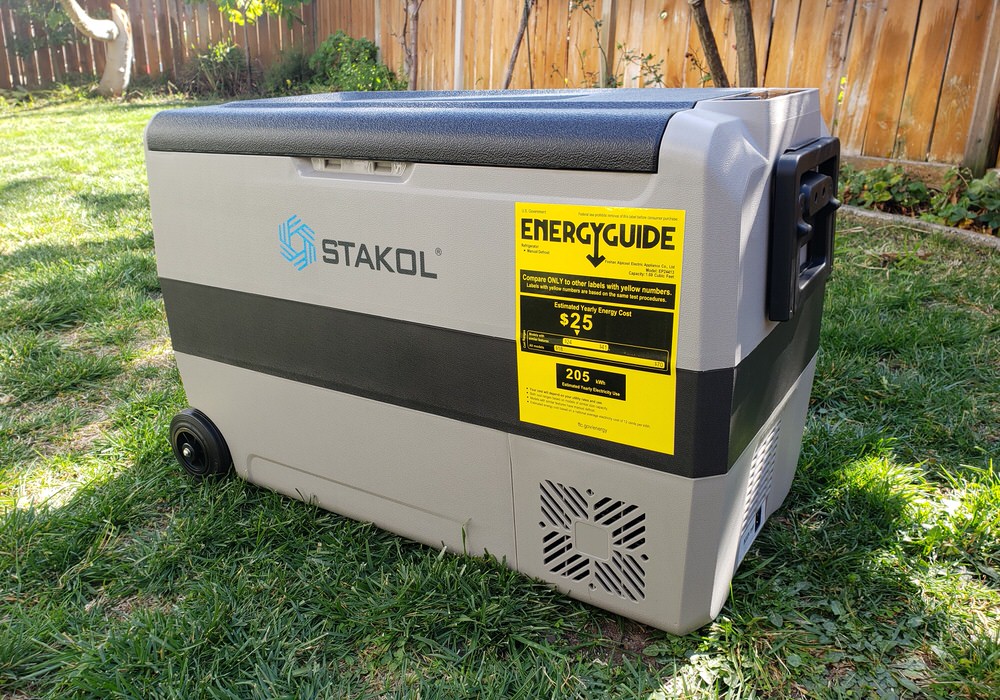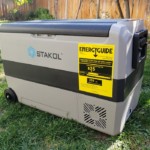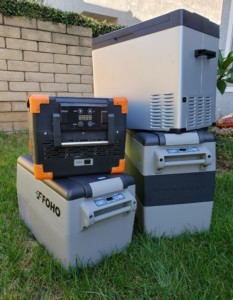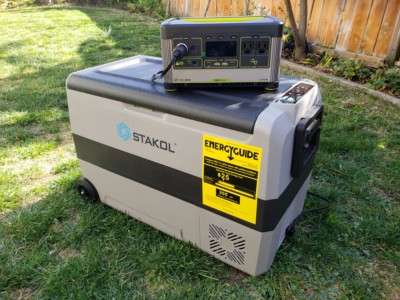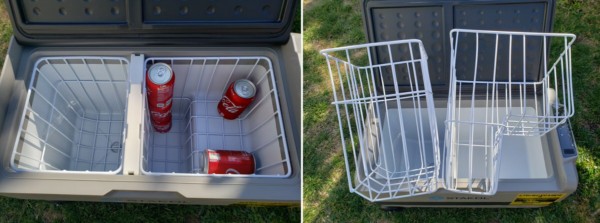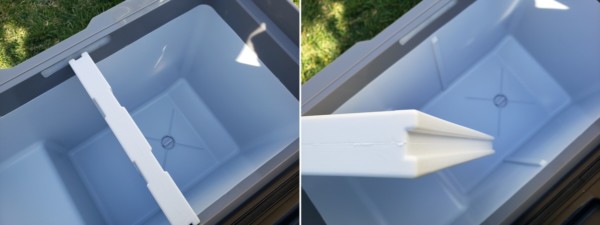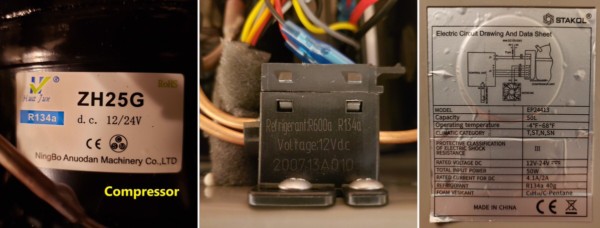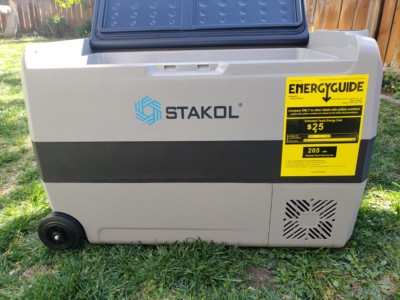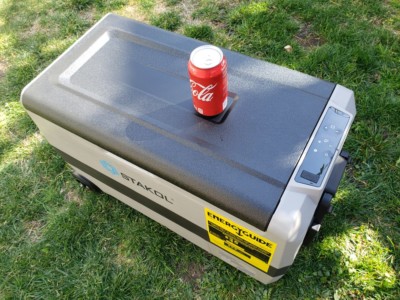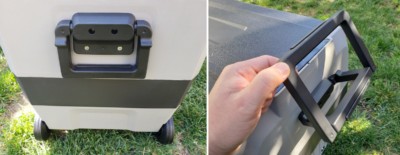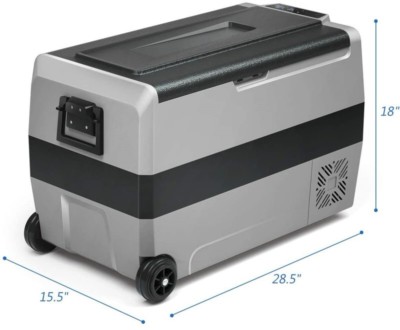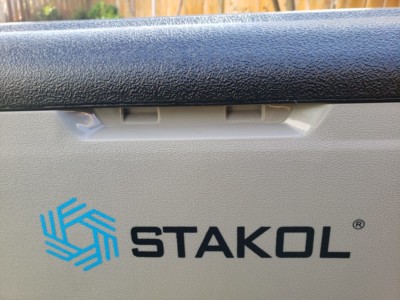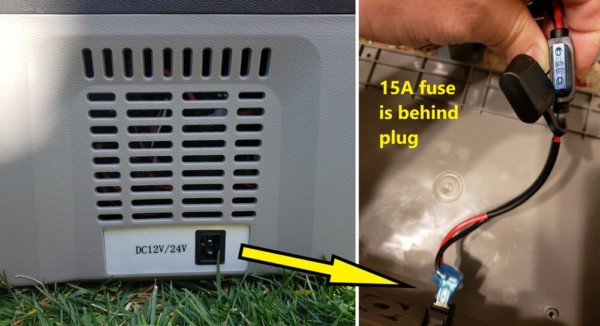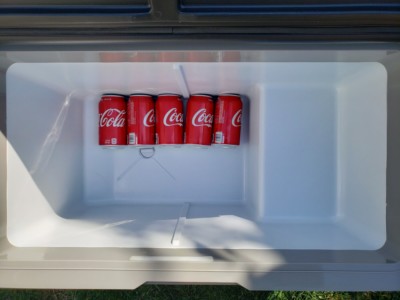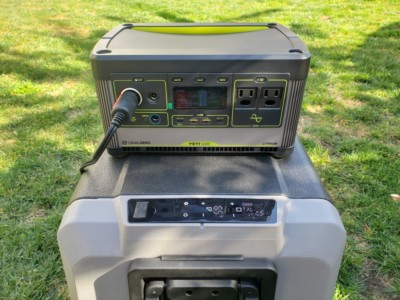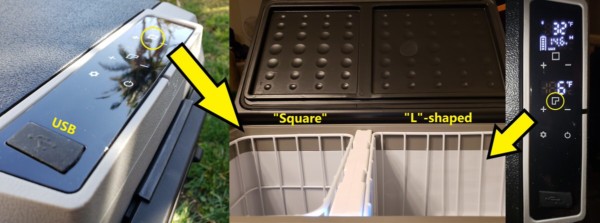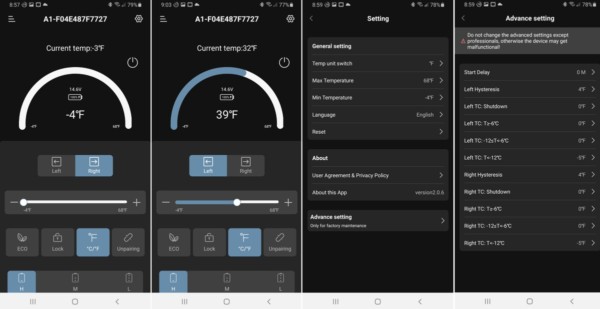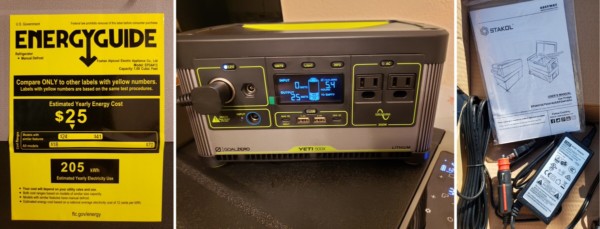Costway 53qt Dual-Temperature Car Freezer/Fridge with Wheels (EP24413/24413-CYPE)
Pros
- Accurate, independent, dual temperatures
- Versatile storage configurations
- Back-saving wheels and drain hole
- Excellent cooling performance
- Low energy usage
Cons
- Slightly noisy but comparable to peers
- Lid difficult to open with one hand
- 15A fuse not easily accessible
- Chest-style lid may be undesirable for some
Contents
Search For A Dual-Temperature Car Freezer
It has been nearly a year since I purchased my first car freezer, and since then I had reviewed and compared six of them from friends, coworkers, and family. Each one had positives and negatives, and even though the Foho BCD-32 (34qt) and BCD-52 (55qt) were my favorites, none were perfect. Perhaps more interesting was that they all (including those by Smittybilt, Whynter, and Costway) were manufactured by Alpicool who also sell car freezers under their own brand. Yet, the Fohos were the more silent ones and felt solid enough to withstand a nuclear explosion.
My best friend and I came up with the idea to bring ice cream to surprise our kids with when it was safe to go camping again. But, we did not want to bring two, separate appliances and possibly end up with an extra one sitting unused in the car once its frozen content was consumed. Powering two would also require an additional battery power station.
I set out to find an affordable car freezer with two, truly distinct cooling spaces that hopefully also had:
- Separate temperature controls for two zones
- Ability to convert into a larger, single zone
- Wheels for easier transport
- Drain hole for cleanup
- Wire racks to take content in and out
- Phone app to remotely check and control unit
It was surprisingly not easy, but I eventually found and liked the feature set of the Costway 53qt/50L Car Freezer (EP24413/24413-CYPE). How was it? Almost perfect… almost.
Note: Costway’s EP24413 dual-temp car freezer appears to be a clone of the popular Alpicool T50.
In A Nutshell
The Costway 53qt Car Freezer looked like a rebranded, less expensive Alpicool T50, and like others manufactured by Alpicool, its controls, settings, and performance would be similar to the appliances I had previously reviewed. It did strike me with surprise that “Stakol“, not “Costway”, was the brand showing on the side of this freezer even though the manual referenced both companies. Perhaps equally unexpected was the welcome presence of a yellow EnergyGuide label that I rarely had seen with past products in their class.
I very much liked the aesthetics of this one over my favorites, the Foho BCD-32 and BCD-52, with its clean lines and tough-looking exterior. The chest-style lid firmly stayed shut and required both hands to open on a light fridge, but was not a problem with heavier loads. The wheels helped move the appliance around with ease, and both handles on each side were extendable and stowed away magnetically. The compressor is rated for rough roads up to 30 degrees steep for short periods at a time.
The inside comprised of two storage compartments, each with a removable wire rack and separated by an unattached, plastic divider in the middle. Cleanup was simple through the addition of a drain hole, and the wire racks allowed for content to be quickly taken in and out. Unlike past appliances I had reviewed, this Costway was able to independently control each section’s temperature, and tests over multiple 48 hour periods confirmed that they were pleasantly accurate: the freezer kept ice frozen at around -4F, and the fridge kept a juice pouch cold at 38F. Reliable thermometers matched the chambers’ settings within expected fluctuations. Remove the center divider, and the entire appliance converted itself into a single, large zone with just one temperature configuration. This opened the possibility to store an entire rack of ribs for a delicious overlanding trip!
Like other car freezers made by Alpicool, it quickly cooled from 74F to 32F within 30 minutes, used between 24W-50W of power, and dropped to -1F within the next half hour. Once the set coldness was reached, the single compressor would shut off until it was time to start up again, conserving energy and providing silence. Set temperatures were stored in memory so you would not have to annoyingly configure them again after an unexpected power loss. Between the two compartments, the larger one farthest away from the touch control display could not be set cooler than the smaller one, and so in dual temperature use, the more compact chamber would act as the freezer.
Tip: A car freezer’s performance and energy consumption depend on the ambient temperature. The cooler the surrounding is, the faster the appliance can chill and the less power is used.
Advanced programming options were available from the physical control panel, and an Alpicool-made smartphone app that also allowed for Bluetooth-based remote control up to 30′ away. It always was nice to be able to check on the appliance’s status from the driver’s seat without having to go dig through the car’s cargo.
As much as I liked this Costway freezer, my biggest gripe was the noise level of the compressor. It was not as quiet as both Fohos, and was as loud as the Domende, Euhomy, Linsion, and Rockpals car freezers I had evaluated. Was it unbearably noisy? No, I had actually gotten used to it, and there are multiple ways to curtail the sound volume. I was also disappointed to find the 15A fuse hidden within the space shared with the compressor instead of being on the outside as the Foho, requiring the removal of multiple screws to get to it.
Between the silent Foho BCD-52 and the slightly louder Costway 24413-CYPE, I could not decide on a favorite for a couple of days, but ultimately, I passed the torch over to the Costway for its dual-temperature controls, back-saving wheels, and versatile storage configurations for nearly the same price. We have a new king in the house!
Note: Costway’s EP24413 dual-temp car freezer appears to be a clone of the popular Alpicool T50.
What’s Good? What’s Bad?
Pros
- Fast cooling
- 74F to 32F after 30 mins in 72F ambient temperature
- 32F to -1F after another 30 mins
- Operating range: -4F to 68F (-20C to 20C)
- No need to buy ice and no pool of cold water at the bottom that could affect the content
- Dual-temperature controls
- Independent temperature controls for two zones
- Cooled accurately without needing calibration. See Temperature Compensation below if you need to adjust
- Freezer section kept ice cold at around 0F, and the other left a juice pouch cold at about 38F during 48-hour test periods
- Larger compartment (farthest away from control panel) can be a fridge and the other a freezer
- Bigger chamber cannot be set colder than the smaller one, but both can be the same
- Independent temperature controls for two zones
- Single temperature conversion with one large compartment
- Plastic center divider can be removed to create one big partition with one temperature setting
- Can store longer items like racks of ribs
- Bottom portion of control panel turns off when center divider is detached
- Plastic center divider can be removed to create one big partition with one temperature setting
Removal of center divider turns two, separate compartments with independent temperature controls into a large one with one coldness setting.
- Capacity: 1.69 cu ft capacity (53qt/50L) – Roughly 59 soda cans
- Configurable for different use cases
- Two-partition layout
- Included wire racks help organize items and make for quick content withdrawals
- Left side (Square symbol on control panel) usable space: 9.5″ W x 10.5″ L x 14.5″ H
- Right side (L-shaped symbol)
- Deep part: 5.5″ W x 10.5″ L x 14.5″ H
- Shallow part: 6″ W x 10.5″ L x 8″ H
- Center divider: 1.25″ W x 10.5″ L x 14.5″ H
- One-partition layout (divider/wire racks removed)
- Usable space: 22.25″ W x 10.5″ L x 14.5″ H (minus 6″ W x 10.5″ L x 6.5″ H lost at Shallow part)
- Exterior Dimensions: 28″ W x 14″ L x 18″ H / 15.5″ L with wheels / Weight: 35 lbs
- Fits a Honda Accord trunk
- Efficient compressor
- When ON (to cool): 24W-50W used
- When OFF (idle): 0W-2W
- Usable on rough roads up to 30 degrees steep for short periods of time (5 degrees max for longer durations)
- Anti-shake design keeps compressor protected
- Quiet operation (up to 45 dB). Foho BCD-32/BCD-52 are 40 dB max
- Refrigerant: R134a with 40g (+/- 0.5g) mass charge
- According to a thermal engineering website, R134a is a “non-flammable gas used primarily as a ‘high-temperature’ refrigerant for U.S. refrigeration and [car ACs]… [It] is non-toxic, non-flammable and non-corrosive.”
Tip: The colder the ambient/surrounding temperature is, the less often the compressor will turn on to cool/maintain the inside. An insulated, protective cover (like the one made for the Alpicool T50 that works with this Costway) should be considered to help maintain internal temperatures better.
- Power options
- 12V or 24V car adapter (draws 2-4A on 12V)
- 11′ cable included
- 3 battery protection levels to prevent car battery from running down
- If car’s 12V port has a bypass to work directly off the battery, freezer can be used when vehicle is off. Many SUVs, trucks, minivans today have such output. See car’s owner manual
- 100-240V AC wall plug, outputting 14.5V @ 6A (or 87W)
- Auto resume: Continues operation when power is cut off and later restored
- 12V or 24V car adapter (draws 2-4A on 12V)
- Tough exterior with clean lines
- Plastic wheels for easier transport that my back is very thankful for
- Lid closes VERY securely
- Chest style requires less vertical clearance to open
- Energy modes: Max, Eco
- Touch-sensitive Control Panel: Power, Settings, +/- for each cooling zone
- Phone app: Remotely check, control, program unit via Bluetooth up to 30′ away
- “Car Fridge Freezer” by Alpicool (available for Android, Apple iOS)
- Convenient for adjusting or checking temps from the driver seat without having to dig through the trunk
- Built-in, internal LED light
- Drain hole for easier cleanup. Do not turn upside down to drain!
- USB charging port
- Advanced programming options from control panel or app. See Programming section
- Carry handles on both ends. Can be secured to car with straps
- Overload protection: Replaceable 15A fuse
- Good customer service: My interactions with Costway had been positive in the past
Cons
- “Stakol” branding can confuse buyers into thinking they received the wrong item
- Heavy, especially when full. Use the wheels!
- May be too bulky, though it fits a Honda Accord trunk
- Slightly noisy when compressor is on
- Lid: Difficult to open with one hand unless unit is weighted with heavy content
- Cannot be changed to open from the opposite side or front-open from the control panel
- Fuse hidden inside near the compressor instead of outside next to the plug
- Requires removing screws to get to it
- Manual defrost (like most car freezers in this price range)
- Flexible plastic where power plug is at. Could potentially crack if too much force is applied
- Not waterproof. Keep out of rain
- No built-in cup holders on lid
- Cannot be directly powered by Solar panels via MC4 or Anderson interfaces to make it a solar-powered freezer
- GoSun has a cooler with a built-in solar panel
- No protective/insulating carry bag included
- An insulated freezer maintains its temperature better and uses less energy
Tips
- Important: Let car freezer rest for 10+ hours after delivery to allow refrigerant to settle before use or you will cut the product’s life short!
- Test both compartments with a reliable thermometer prior to use
- If temps are more than +/- 5F degrees off, you may need to re-calibrate one or both zones. See Temperature Compensation
Compressor Power
To set: When powered on, briefly press Settings button to cycle between Max (Default), Eco.
- Max: Useful when surrounding temperature is 86F+ (30C) and Fast-Cool is needed. Runs compressor at a higher speed
- Eco: Uses less energy. Temperature fluctuates slightly. Could ruin compressor in the long run
Battery Voltage Protection
To set: When powered on, hold Settings for 3 seconds. Cycle between High (Default), Medium, Low with Settings button.
- Car freezer will turn off when battery reaches corresponding voltage level. Generally for Alpicool: High 12V / Medium 11.5V / Low 9V
- Incorrect setting could leave you stranded with a non-starting car. When connecting to:
- Battery power station. Use Medium or Low
- Car. Use High or Medium
Power On-The-Go
If you plan on taking the appliance with you on a trip, there are multiple ways to power it. Ensure the source can provide at least 60 watts. Some options:
- 12V/24V DC car outlet
- Battery power station paired with:
- 100W+ Solar panel(s)
- Car charger
- See “Runtime with Battery Power Stations” to find the right battery size for you
- Gas or propane generator
My Traveling Setup
I plug the car freezer into a battery power station while driving. This allows it to continue operating while the vehicle is off. The battery itself is energized via a 12V car charger or solar panels:
Car’s 12V DC outlet > Car charger > Battery power station > Battery’s 12V DC output > Car freezer
My favorites:
- Batteries: Goal Zero Yeti 1500x / Jackery Explorer 1000
- Solar Panels: Goal Zero Nomad 200 / Jackery SolarSaga 100W
- Car charger: Goal Zero Yeti Car Charger (provides a whopping 120W with a 10A outlet)
Programming
To enter programming mode: Turn unit off but keep plugged in to a power source. Hold “Settings” button for 6 seconds until “E1” displays. Cycle through options with “Settings”, change values with “+” or “-“. Accept setting by leaving the screen blinking until it stops a few seconds later. The various configurations can also be changed with the Bluetooth-connected app (which also is the easiest method).
PROGRAM AT YOUR OWN RISK! Improper use may void warranty and/or cause freezer to fail or be damaged.
Legend
- Cooling Zones
- Section on left (farthest away from Control Panel): SQUARE symbol (Control Panel) or “Left” (App)
- Section on right: L-SHAPED symbol (Control Panel) or “Right” (App)
- Option Labels
- Control Panel: “E” value (ie. “E3”)
- App: “Text” shown after “E” (ie. “Hysteresis” for “E3”)
Options
- E1 “Min Temperature”: Lowest temperature that freezer can be set to cool down to. -40C/-40F to Target temp. Default: -20C (-4F)
- Caution: setting the value too low may damage the compressor
- E2 “Max Temperature”: Highest temperature that freezer is allowed to reach. Target temp to 40C/104F. Default: 20C (68F)
- E3* “Hysteresis”: Difference from target temperature before powering up compressor again. 1C/1.8F to 10C/18F. Default: 2C (4F)
- Compressor should stop at target temperature (ie. 4C), and start again when internal temperature is E3’s value above it (ie. 4C + 2C = 6C)
- E4 “Start Delay”: Time delay protection. 0-10 mins. Default: 0 min
- To protect the compressor, it will wait that amount of time after being idle/powered off before turning on again
- E5 “Temp unit switch”: Temperature unit display. C or F. Default: F
- E6* “TC: T >= -6C”: Do not modify. Temperature compensation (for temp set to above -6C/21.2F). -10C/-18F to 10C/18F. Default: 0C (0F)
- Displayed temperature = Detected temperature + Temperature compensation
- Used to match Displayed temperature to what is actually Detected inside the unit
- Displayed temperature = Detected temperature + Temperature compensation
- E7* “TC: -12 <= T < -6C”: Do not modify. Temperature compensation (for temp set to between -12C/10.4F and -6C/21.2F). -10C/-18F to 10C/18F. Default: 0C (0F)
- E8* “TC: T < -12C”: Do not modify. Temperature compensation (for temp set to below -12C/10.4F). -10C/-18F to 10C/18F. Default: -3C (-5F)
- E9* “TC: Shutdown”: Do not modify. Temperature compensation “shutdown”. -10C/-18F to 0C/0F. Default: 0C (0F)
- I have no idea what this is for. Shut down the compressor when a specific, differential value is met?
* Each difference of 1C is 1.8F
Temperature Compensation (TC)
If you find the temperature displayed on the control panel is different than what is actually inside, the discrepancy can result in content overcooling or being too warm. For instance, if you meant to keep fruit cool at a set 40F, but the true temp inside is 32F, you will unintentionally have FROZEN fruit. Or, if you wanted to keep meats frozen at 29F, but the true temp inside is 36F, you may find the content having melted.
The displayed temperature should be roughly the same (by about 5.4F by default) as the actual one inside because the compressor will ONLY stop cooling when the display (not the storage’s true temp) matches the set degrees.
If you find the temperature displayed on the control panel is different than what is actually inside, the discrepancy can result in content overcooling or being too warm.
To correct the discrepancy between the set/displayed temperature and what the internal storage really is, place two, reliable thermometers inside and perform tests with temps set to 0C, -9C, and -20C (one for each of the E6-E8 TC ranges). I found the calibration easier to start with the warmer values first. If, for example, the display is 8C, 4C, and 1C higher (for each range) than what is inside, set the temperature compensations to: E6 = -8C, E7 = -4C, and E8 = -1C.
Reset Settings
If you find yourself having screwed up the E1-E9 settings, you can reset them to factory defaults.
- Enter Programming Mode from the physical control panel
- You should now be at the “E1” screen
- From the TOP section of the control panel (marked by SQUARE symbol), hold “+” and “-” buttons together for 3 secs until “888” displays
Runtime with Battery Power Stations
- To calculate how long the car freezer could be used for with a power station depends on its battery capacity (Wh) and how much power (W) the appliance draws
- Examples are with a Jackery Explorer 1000 (1002 Wh). Halve the time when used with a Goal Zero Yeti 500x (500Wh)
- Plugged into AC port: 1002 Wh x 0.85 / Device Wattage
- About 10-15% (0.85) of power is lost during conversion from DC (battery) to AC, which is normal for all power stations
- As short as 17 hours (1002 Wh x 0.85 / 50W)
- Informal testing found an estimated use of 500-600 Wh/day as a fridge. It was idle much of the time
- Plugged into DC port: 1002 Wh / Device Wattage
- As short as 20 hours (1002 Wh / 50W)
- In reality, because the unit stays IDLE most of the time, it should last a LOT longer than the hours listed above
- Plugged into AC port: 1002 Wh x 0.85 / Device Wattage
The car freezer only uses power to reach or maintain the set temperature. Once there, it goes idle to minimize power draw. As such, the appliance could last a lot longer than the times listed above. Ambient temperature (how hot it is around the unit) greatly impacts how often and for how long the freezer’s compressor kicks in. The colder it is outside, the less power is used.
Cooling Efficiency
- The colder the set temperature and/or the warmer the ambient (surrounding) heat, the more energy will be used
- Keep in a cool location and out of direct sunlight for best efficiency
- Consider putting the appliance in an insulated bag for better cooling
- Ensure adequate air flow (4″+) on all sides of the unit, especially where the fan vents are
- The more frozen/cold items are inside, the longer they can stay cool/frozen. Avoid opening the lid too often or for too long
- An insulated, protective cover (like the one made for the Alpicool T50 that works with this Costway) should be considered to help maintain internal temperatures better
Maintenance
- Ensure lid seal is clean and unobstructed to keep cold air from escaping
- Clean inside with a damp cloth every week
- Use sodium bicarbonate (baking soda) dissolved in lukewarm water to clean anything dirty
- Allow inside to dry before closing lid and putting away
- Do not use detergent, soap, or abrasive/sharp products
- Never clean under running water
- Do NOT store the unit on its side. Always keep it upright to prevent damage to the compressor
- To defrost and remove excess ice, power off the unit and wipe dry, then power back on
- Do not allow a large amount of frost to build up on the inside of the walls as that will make cooling less efficient
Error Codes
If an error occurs, one of the following codes will display on the LCD:
- F1: Low power protection activated. Change H (High) to Medium or M to Low
- F2: Fan overloaded. Turn unit off for 30 minutes to let cool
- F3: Compressor overworked. Turn off for 30 mins to let cool
- F4: Compressor overloaded or working at low speed. Turn off for 30 mins to let cool
- F5: Compressor controller module overheated. Turn off for 30 mins and let cool in a ventilated place
- F7/F8: Temperature sensor error. Turn off and back on. Check sensor terminal(s)
Bonus: Defrosting and How Refrigerators Work
I was fortunate (or unfortunate) to troubleshoot our home refrigerator a few years ago when it could not keep food frozen nor items cool in the fridge section, resulting in nearly a thousand dollars in lost food and medication… twice. SEARS technicians were useless and considered the unit a total loss. After having spent months researching and learning, I gained an understanding of how refrigerators work and fixed it myself. (If you are curious, 2 thermistors needed to be replaced at a couponed cost of $86.)
- A refrigerator unit consists of two compartments: freezer and refrigerator (for drinks, fruit, veggies, etc.)
- Freezer pushes cold air into the fridge section via a fan, and the warmer air from the fridge is returned to the freezer for cooling
- If the freezer fails, so will the fridge
- The compartments each have a thermistor (a resistance thermometer) to sense how cold both sections are
- Compressor (and associated fan) is turned on or off as needed to maintain the temperatures
- Over a long time, as you keep opening the door and let warmer air enter the freezer, the air moisture turns into frost/ice along the walls and shelves
- Cooling efficiency diminishes and could spoil food faster when safe temperatures cannot be maintained
- Frost build-up reduces available freezer space
- For optimal efficiency, you should defrost the freezer at least once a year by unplugging the appliance and letting the ice melt off the sides and shelves
- Have a towel ready to soak up the melted water and wipe dry the sides before turning it back on
- Today’s refrigerators have an auto-defrost cycle where heat is applied to the freezer’s evaporator coil (which is responsible for cooling)
- Melted water leaves the freezer and is evaporated by a fan
- Cycle can occur once or multiple times a day, resulting in fluctuating temperatures
- Auto-defrosting freezers cost more, use more energy, make more noise, but requires less maintenance
This car freezer (like most, if not all, in its class) does NOT have an auto-defrost cycle, and so requires occasional, manual defrosting when used for an extended period of time.
Final Thoughts
After having worked with a total of seven car freezers during nearly one full year, I had been disappointed that none checked every box on my list. The dual-temperature ones were too expensive and also could not be converted into a larger, single zone. All of the larger ones were too heavy, lacked wheels for easier transport, and nearly none had a drain hole for simple cleanup. Most also did not include any wire racks, and some could not be controlled with a smartphone.
The Foho BCD-32 and BCD-52 were my overall favorites among the first six despite lacking many of the above-listed features, but then the Costway 53qt “Stakol” (EP24413) came about, and I was very excited! It had independently controllable temperatures for two compartments that could easily convert into a single, larger one, came with wire racks, had wheels and a drain hole, looked solidly built, and could be monitored and controlled through a Bluetooth-based, smartphone app. An insulated, protective cover should be considered to help maintain internal temperatures better. Pricing was good, energy usage was low, and best of all, the cooling temperatures were accurate for both zones right out of the box. In addition, it could be powered by AC, 12V DC car chargers, and solar panels with battery power stations (like the Goal Zero Yeti 1500x and Jackery Explorer 1000). Sounded like a perfect fridge, right? Almost.
The Costway 53qt car freezer was not perfect. The lid could be difficult to open one-handed, and it was not as quiet as the Foho units (though it was on par with most of the other appliances I had worked with). Ultimately, the versatility and extra features of the Costway made it my new, favorite car freezer.
Note: Costway’s EP24413 dual-temp car freezer appears to be a clone of the popular Alpicool T50.
I very much look forward to the next overlanding/boondocking trip with friends and family where the kids could be surprised with cones of ice cream in the summer — in the middle of nowhere. Coolest dad ever. I know.
Where To Buy
- Costway 53qt/50L Car Freezer (EP24413/24413-CYPE)
- Alpicool 53qt/50L Car Freezer (T50)
- Alpicool T50 Insulated Protective Cover (also works with Costway EP24413)
Related Reviews
- Car Freezers
- Car Freezers with Battery
- Acopower LiONCooler X40A (42qt) with Solar charging
- Bodega Cooler Mini P15 (16qt) with 2 Battery Slots

